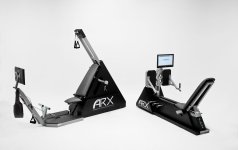AlexThePhysique
New member
Hey all!
Just bumped on that stuff surfing the internet. Found it interesting so sharing with you all.
Robotic Exercise Machines are high-tech devices that use elements of robotics, artificial intelligence (AI), and sensor technologies to create more efficient, precise, and personalized workouts. These machines can automatically adjust resistance, track movements, correct exercise technique, and adapt to the user's physical abilities in real time.
1. Automatic Load Adjustment: Robotic machines can automatically change the weight or intensity of resistance based on the user's strength and endurance. This allows for the creation of personalized training programs tailored to specific goals (e.g., hypertrophy, strength, endurance).
2. Feedback and Technique Correction: These machines can be equipped with sensors and cameras that track the user's movements and provide recommendations for improving technique to avoid injury and enhance exercise efficiency.
3. Personalized Workouts: Using artificial intelligence, the machines can select an optimal workout program based on the user's fitness level, goals, and preferences. They can automatically adapt the training sessions according to progress.
4. Real-Time Monitoring: Robotic exercise machines often feature monitoring functions that track parameters such as heart rate, blood oxygen levels, muscle activation, and other metrics to provide more accurate data about the user's physical condition.
5. Rehabilitation and Recovery: Some robotic machines are used in medical and sports rehabilitation. They help in recovering from injuries by controlling movements, minimizing the risk of further damage, and gradually increasing load to safely restore muscle strength and functionality.
Examples of Robotic Exercise Machines:
- ARX (Adaptive Resistance Exercise): One example of a robotic exercise machine that uses dynamic resistance adjustments in real time based on the user's efforts. Such machines allow precise regulation of the load, adapting to a person's strength level.
- VIRTUS: A system of machines that uses robotic components to assist movement and improve exercise efficiency. It applies technology to enhance training and rehabilitation, offering personalized approaches.
- RoboCoach: This machine uses sensors and algorithms to analyze exercise form and provide recommendations for adjustments to improve technique, helping to prevent errors and injuries.
The machines can adapt to individual needs, creating programs that consider fitness levels, goals, and even current physical limitations. By controlling technique and adjusting the load, robotic machines can significantly reduce the risk of injury and overtraining. Technology that tracks all exercise parameters and adjusts them can help users achieve their goals more quickly and efficiently. Machines that are tailored to different physical capabilities can benefit beginners, experienced athletes, and those recovering from injuries.
Robotic exercise machines represent the future of the fitness industry, significantly enhancing training efficiency, providing precise load adjustments, and correcting user technique. These devices are especially relevant for personalized training, rehabilitation, and injury prevention.
What do you think or maybe you have already tried? I personally go for old-school!
Just bumped on that stuff surfing the internet. Found it interesting so sharing with you all.
Robotic Exercise Machines are high-tech devices that use elements of robotics, artificial intelligence (AI), and sensor technologies to create more efficient, precise, and personalized workouts. These machines can automatically adjust resistance, track movements, correct exercise technique, and adapt to the user's physical abilities in real time.
1. Automatic Load Adjustment: Robotic machines can automatically change the weight or intensity of resistance based on the user's strength and endurance. This allows for the creation of personalized training programs tailored to specific goals (e.g., hypertrophy, strength, endurance).
2. Feedback and Technique Correction: These machines can be equipped with sensors and cameras that track the user's movements and provide recommendations for improving technique to avoid injury and enhance exercise efficiency.
3. Personalized Workouts: Using artificial intelligence, the machines can select an optimal workout program based on the user's fitness level, goals, and preferences. They can automatically adapt the training sessions according to progress.
4. Real-Time Monitoring: Robotic exercise machines often feature monitoring functions that track parameters such as heart rate, blood oxygen levels, muscle activation, and other metrics to provide more accurate data about the user's physical condition.
5. Rehabilitation and Recovery: Some robotic machines are used in medical and sports rehabilitation. They help in recovering from injuries by controlling movements, minimizing the risk of further damage, and gradually increasing load to safely restore muscle strength and functionality.
Examples of Robotic Exercise Machines:
- ARX (Adaptive Resistance Exercise): One example of a robotic exercise machine that uses dynamic resistance adjustments in real time based on the user's efforts. Such machines allow precise regulation of the load, adapting to a person's strength level.
- VIRTUS: A system of machines that uses robotic components to assist movement and improve exercise efficiency. It applies technology to enhance training and rehabilitation, offering personalized approaches.
- RoboCoach: This machine uses sensors and algorithms to analyze exercise form and provide recommendations for adjustments to improve technique, helping to prevent errors and injuries.
The machines can adapt to individual needs, creating programs that consider fitness levels, goals, and even current physical limitations. By controlling technique and adjusting the load, robotic machines can significantly reduce the risk of injury and overtraining. Technology that tracks all exercise parameters and adjusts them can help users achieve their goals more quickly and efficiently. Machines that are tailored to different physical capabilities can benefit beginners, experienced athletes, and those recovering from injuries.
Robotic exercise machines represent the future of the fitness industry, significantly enhancing training efficiency, providing precise load adjustments, and correcting user technique. These devices are especially relevant for personalized training, rehabilitation, and injury prevention.
What do you think or maybe you have already tried? I personally go for old-school!
